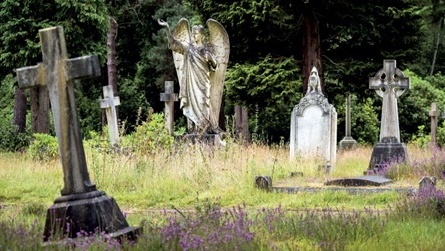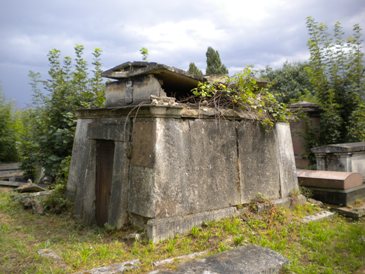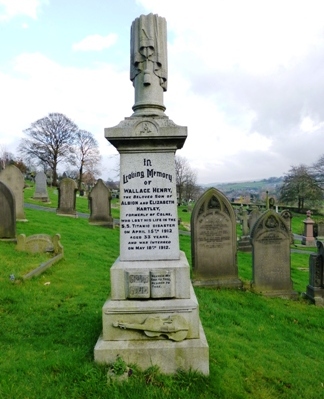Saving Cemeteries
Rebecca Barrett and Jenifer White
 |
||
| Fine sculpture in Brookwood Cemetery, Woking (All photos: Historic England) |
From the Arcadian serenity of Kensal Green Cemetery (one of London’s ‘Magnificent Seven’) to the traditional Islamic garden of Woking’s Muslim Burial Ground, cemeteries are places of tranquillity and remembrance. They are biographies of local communities and help to tell the stories of individuals, their lives, beliefs and fashions.
In England, over 100 cemeteries are now included in the Register of Parks and Gardens of Special Historic Interest for their landscape design. Countless others have individual monuments or structures which are listed. Historic England (HE) champions these special places by seeking to understand their importance and by protecting them, sharing their stories and helping to conserve them for all to enjoy.
WHY ARE CEMETERIES IMPORTANT?
Every community in the UK, past or present, has a burial ground. They come in all shapes and sizes – ancient barrows, burial pits associated with historic epidemics, modest rural and urban churchyards, ambitious Victorian cemeteries with picturesque landscapes and 20th-century military burial grounds with a dignified uniformity. They are special sanctuaries for the dead and those who mourn them; quiet places to relax and meditate.
The modern history of our cemeteries can be traced back to the mid-17th century. With traditional churchyards reaching capacity and growing concerns about unsanitary conditions, there was a revival of the ancient Roman idea of siting burial grounds on the outskirts of towns. Bartholomew’s Yard burial ground in Exeter, which opened in 1637 (and is now a Grade II* registered landscape), was one of the first. It was almost another 200 years, however, before the first public cemetery opened in Norwich (The Rosary, also Grade II* registered).
Many of the early cemetery companies were set up by dissenters interested in creating burial spaces which were independent of the established church. It was private enterprise, however, that provided the first public cemetery in the capital – Kensal Green Cemetery (also known as All Souls Cemetery), which opened in 1833. In 1850 The Metropolitan Interment Act provided an alternative, allowing for publicly funded cemeteries in London. This model was extended across the country just three years later, leading to a boom in the construction of public cemeteries.
These Victorian cemeteries reveal much about the fashions and practices of the time, often borrowing from eminent designers such as Humphry Repton. Indeed, many cemeteries from this period were laid out in the picturesque style, with ceremonial routes for funeral cortèges, returning meandering paths, serpentine lines of trees and carefully planned vistas. These cemeteries were also rich in architecture and sculpture. Grand chapels were often placed at the heart of the designed landscape, with lodges, gates and boundary walls providing a secure haven. Monuments were positioned with equal care. Their design reflected the interests and status of those interred while reminding the visitor of the greater Arcadian vision for the cemetery.
 |
|
| Cambridge American Cemetery: dedicated in 1956 and administered by the American Battle Monuments Commission, the cemetery contains the remains of some 4,000 US military personnel who lost their lives during WWII. |
Cemetery design continued to develop during the 20th century in response to changing fashions and the growing number of cremations. Ambitious Victorian landscapes were also expensive and resource-intensive to look after. As a result, a simpler cemetery aesthetic developed and continues to evolve in the 21st century.
As well as being valuable windows into the past, cemeteries are important places for communities today. They are very often ‘green lungs’ in densely built up areas; surviving fragments of countryside from previous centuries, now locked within our urban fabric. Whether still working or closed to burials, cemeteries are important public spaces. Who would have thought that London’s plague pits, including Christchurch Gardens in Westminster, would now be some of the most popular picnic spots in the capital?
Organisations such as Natural England and Caring for God’s Acre also highlight the ecological significance of cemeteries. Woodland and species-rich grassland are havens for wildlife. Added to this is their arboricultural significance, particularly those designed as arboreta – Abney Park Cemetery in the London Borough of Hackney is just one example. Many cemeteries also incorporate trees of considerable age and stature from earlier landscapes.
WHAT ARE THE COMMON THREATS TO HISTORIC CEMETERIES?
Sadly, too many of our cemeteries have suffered from years of under-investment. The result is often an appearance of neglect and decay – overgrown sites where the legibility of the designed landscape has been eroded, monuments are falling apart and veteran trees are hemmed in by secondary woodland.
One of the main reasons for this change in fortunes was the financial management of cemeteries. Many of the private cemeteries set up in the mid19th century, for example, were under-capitalised from the outset. Buildings and structures once considered assets soon became liabilities. As time passed and families dispersed, the private upkeep of family monuments also became the exception rather than the rule, resulting in inevitable decay. In response, some cemeteries simply closed their gates, while the management of others was transferred to the local authority.
Increasingly, however, local authorities are struggling to find the resources to cover the basic upkeep of these cemeteries, let alone the backlog of repairs created by decades of under-investment and inadequate funds left for the maintenance of monuments ‘in perpetuity’. This has often resulted in vulnerable headstones and other grave markers being removed or uprooted and laid flat. Both of these solutions undermine the significance of our historic cemeteries.
The gothic taste for overgrown cemeteries with ivy-clad tombstones and tumbling monuments poses another threat. Of course there is some appeal to a ‘wild’ landscape, but these are complex sites that need careful management. Unchecked vegetation is not benign. It poses serious challenges to the conservation of cemetery buildings and structures, as well as their setting. It can mask historic landscape design and cause the destabilisation, and eventually the collapse, of its built features. This deterioration only adds to the difficulties and final costs of conservation.
 |
||
| Vegetation growth is causing damage to the Grade II listed monument of Thomas Fenwick in Kensal Green Cemetery, now prioritised for repair. |
Historic cemeteries are also vulnerable to long-held assumptions about ecology and heritage. All too often these two ‘interests’ are presumed to be at odds with each other, pursuing competing and incompatible objectives in the management of our cemeteries. This is far from the case. Well-planned management can support a mosaic of habitats, while conserving and better revealing the historic landscape. Shady monocultures of ivy and sycamore achieve neither of these objectives. Management is therefore essential to both biodiversity and the preservation of valuable heritage assets.
Working cemeteries have their own pressures. One of these is the need to find new burial space and to respond to changing rituals, such as the increasing number of cremations. This can lead to developments which undermine the historic significance of the site.
In Kensal Green Cemetery, for example, paths originally designed as part of a serpentine walk have been inappropriately filled. The potential reuse of historic graves is another controversial topic, not least because of the associated complexities – incomplete cemetery records, efforts to trace descendants, the incorporation of new inscriptions on historic headstones and uncertainties about the stability of vaults.
In light of these threats, cemeteries are high on the agenda at HE. There are nine cemetery landscapes currently on the Heritage at Risk Register, together with 72 separately listed assets. These include cemetery chapels, catacombs, gate lodges, boundary walls and individual monuments.
HOW CAN WE BETTER CONSERVE OUR HISTORIC CEMETERIES?
At the heart of any solution must be a reawakening of interest in these special places. We need to raise awareness of our historic cemeteries, champion them and ensure they are valued as vital green spaces for the well-being of our communities. Through the work of HE’s heritage at risk, research, and listing teams, together with many others, we are starting to achieve this.
HE’s listing team continues to add the most important examples of cemetery landscapes and monuments to the National Heritage List for England. This helps to protect and raise awareness of assets that are particularly significant, whether by virtue of their architectural interest or their historic associations. One recent example is Wallace Hartley’s gravestone in Colne Cemetery, Lancashire, which was listed in March 2015. Hartley was the band leader on RMS Titanic. He became a national hero when it was reported that the band continued to play as the ship sank on her maiden voyage. The gravestone includes a relief carving of a violin and a music book open at ‘Nearer, my God, to Thee’, thought to have been the last hymn the band performed.
Another example is the Novo Cemetery in the London Borough of Tower Hamlets, registered in April 2014. The cemetery is important as the sole remaining portion of one of Britain’s earliest post-Resettlement Jewish cemeteries (the ‘Resettlement’ or ‘Readmission’ was the reversal in 1656 of Edward I’s expulsion of the Jews from England in the 13th century). The cemetery’s connection with the London Sephardi community goes back nearly three centuries. By researching cemeteries that are under-represented or under threat we can capture their historic and communal values and so make a powerful case for their protection.
 |
|
| Wallace Hartley’s gravestone in Lancashire, which was Grade II listed in March 2015 |
HE’s heritage at risk teams up and down the country are also working closely with cemetery companies, local authorities and friends groups to find imaginative solutions to the conservation of vulnerable cemeteries. The aim, in many instances, is to address the backlog of repairs and management issues, while thinking about ways to achieve long-term sustainability.
A robust conservation management plan is an essential ingredient to achieve this. It is a good way of teasing out what is important and why, what needs to be done and how to go about it. The best plans are developed collaboratively and take into account all interests to ensure that judgements about future management are appropriately balanced. They should be accessible and easy to use for all stakeholders, and should include practical guidance.
Friends groups also have a key role to play and there are many examples of their efforts to rescue cemeteries from neglect. Whether helping to record monuments, clearing overgrowth, offering guided tours or fundraising, friends groups continue to raise the profile of these valuable sites. Getting the skills and governance of these groups right is critical. There needs to be a clear division of responsibilities, a realistic and shared vision, and an appropriate range of expertise. This is support and guidance which HE’s heritage at risk teams are able to provide.
In London, for example, HE has been working closely with the General Cemetery Company and the Friends of Kensal Green Cemetery to prioritise the repair of monuments currently on the Heritage at Risk Register. This work has been informed by a thorough condition survey of 32 monuments which were classified as ‘at risk’. Repairs to the monuments of Emile Blondin and Frederick Winsor, together with improvements to their landscape setting, are now complete. A second phase of repairs should begin later this year.
HE continues to work closely with Natural England to produce guidance on cemetery conservation. Their joint publication Paradise Preserved (see Further Information), for example, shows how to balance differing interests and values, including heritage and wildlife. The voluntary organisation Caring for God’s Acre is another useful source of advice and information.
The Heritage Lottery Fund (HLF) is also a generous supporter of historic cemeteries. It has broadened its ‘Parks for People’ programme to include cemeteries. The HLF can help develop holistic conservation projects which engage visitors and local communities while ensuring long-term sustainability. West Norwood Cemetery in London, Rectory Lane Cemetery in Berkhamsted and Sheffield General Cemetery were all beneficiaries in January 2016. Grants have also been awarded to Northwood on the Isle of Wight, London Road Cemetery in Coventry, Wrexham Cemetery and Brompton Cemetery in London.
FINAL THOUGHTS
Our historic cemeteries are highly valued, not only as places of commemoration but as oases in built-up areas, havens for wildlife and showcases for decorative sculpture. But they are clearly vulnerable. As resources continue to diminish and repair bills rise, the key will be to reawaken interest in these sites and to ensure that they are both sustainable in the long-term and valued as vital green spaces for all communities to enjoy.
~~~
Further Information
C Fairbairn, Reuse of Graves, House of Commons Library Briefing Notes, 2014
C Fairbairn, Unsafe Headstones in Cemeteries, House of Commons Library Briefing Notes, 2012
Historic England, Caring for Historic Graveyard and Cemetery Monuments, 2011
Historic England, Paradise Preserved, 2007
S Rutherford, The Victorian Cemetery, Shire Publications, Oxford, 2008



